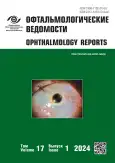Possibilities of reparative therapy in the treatment of patients with xerotic changes in the cornea
- 作者: Brzheskiy V.V.1, Bobryshev V.A.1
-
隶属关系:
- Saint Petersburg State Pediatric Medical University
- 期: 卷 17, 编号 1 (2024)
- 页面: 63-70
- 栏目: Problems of ophthalmic pharmacology
- URL: https://journals.rcsi.science/ov/article/view/255194
- DOI: https://doi.org/10.17816/OV625682
- ID: 255194
如何引用文章
详细
In recent years, in the treatment of patients with dry eye syndrome, drugs that, along with moisturizing, also have specific metabolic properties, due to the additional medicinal ingredients contained in them, deserve more and more attention. The article presents comparative data on the preparations of “artificial tears” and so-called keratoprotectors registered in Russia. In addition, a number of experimental and clinical studies by domestic authors evaluating the pharmacological and clinical effect of the new keratoprotector SPHERO®oko were reviewed. Much attention is also paid to the consideration of the original direction of SPHERO®oko application — its introduction into the corneal stroma (together with a dye) for cosmetic and functional keratopigmentation in the presence of extensive iris defects. The authors of the literature review, taking into account the results of numerous experimental studies and some clinical observations, believe that the use of SPHERO®oko has quite great opportunities in the complex treatment of xerotic changes of the cornea and conjunctiva. At the same time, it is of interest to continue the research on the possibilities of intrastromal administration of colored SPHERO®oko for keratopigmentation in the presence of extensive iris defects.
作者简介
Vladimir Brzheskiy
Saint Petersburg State Pediatric Medical University
编辑信件的主要联系方式.
Email: vvbrzh@yandex.ru
ORCID iD: 0000-0001-7361-0270
http://www.eye-gpma.ru/?p=brzheskij65
MD, Dr. Sci. (Medicine), Professor
俄罗斯联邦, 2 Litovskaya st., Saint Petersburg, 194100Vsevolod Bobryshev
Saint Petersburg State Pediatric Medical University
Email: vvbrzh@yandex.ru
ORCID iD: 0000-0002-3999-7173
俄罗斯联邦, 2 Litovskaya st., Saint Petersburg, 194100
参考
- Jones L, Downie LE, Korb D, et al. TFOS DEWS II Management and therapy report. Ocul Surf. 2017;15(3):575–628. doi: 10.1016/j.jtos.2017.05.006
- Brzheskiy VV, Egorova GB, Egorov EA. Dry eye syndrome and ocular surface diseases: clinic, diagnosis, treatment. Moscow: GEOTAR-Media, 2016. 464 p. (In Russ.)
- Brzheskiy VV. Combined artificial tear medications in the treatment of patients with dry eye syndrome. Russian Ophthalmological Journal. 2022;15(2):154–159. EDN: EQERUJ doi: 10.21516/2072-0076-2022-15-2-154-159
- Williams D. Improving ophthalmic tear replacement therapies: A bioengeneering approach: mini review. Curr Trends Biomed Eng Biosci. 2017;2(3):555589. doi: 10.17863/CAM.11344
- Brzheskiy VV, Popov VYu, Kalinina NM, Brzheskaya IV. Prevention and treatment of degenerative changes in ocular surface epithelium in patients with dry eye syndrome. The Russian annals of ophthalmology. 2018;134(5):126–134. EDN: YNPYDR doi: 10.17116/oftalma2018134051126
- Fallacara A, Baldini E, Manfredini S, Vertuani S. Hyaluronic acid in the third millennium: Review. Polymers. 2018;10(7):701. doi: 10.3390/polym10070701
- Fallacara A, Manfredini S, Durini E, Vertuani S. Hyaluronic acid fillers in soft tissue regeneration. Facial Plast Surg. 2017;33(1):87–96. doi: 10.1055/s-0036-1597685
- Krishna N, Brown F. Polyvinyl alcohol as an ophthalmic vehicle: Effect on regeneration of corneal epithelium. Amer J Ophthalmol. 1964;55(2):99–106. doi: 10.1016/0002-9394(64)92038-0
- Sevastianov V, Perova N. Part I. Extracellular matrix biomimetics. Chapter One. Multicomponent hydrogel biomimetics of extracellular matrix. In: Sevastianov VI, Basok YB, eds. Biomimetics of extracellular matrices for cell and tissue engineered medical products. United Kingdom: Cambridge Scholars Publishing, 2023.
- Maychuk DYu, Tarkhanova AA, Pronkin IA. Ophthalmic products with extracellular matrix components. Their effectiveness in the process of corneal repair in neurotrophic, herpetic, recurrent keratitis and erosions. Fyodorov journal of ophthalmic surgery. 2022;(2):91–100. EDN: UTJFNG doi: 10.25276/0235-4160-2022-2-91-100
- Pronkin IA. Method of therapy of recurrent corneal epithelial defects based on 1.5 % collagen-containing gel corneal epithelial protector [dissertation abstract]. Moscow, 2017. 24 p. (In Russ.)
- Semakina AS. Experience of using corneal epithelium protector gel for the treatment of corneal erosion for a patient after radial keratotomy. Ophthalmology in Russia. 2022;19(2):441–443. EDN: NYHFGX doi: 10.18008/1816-5095-2022-2-441-443
- Mackie IA. Chapter 205: Neuroparalytic keratitis 370.35 (Neurotrophic keratitis, Trigeminal neuropathic keratopathy). In: Roy FH, Frederick WF, Frederick TF, editors. Roy and Fraunfelder’s current ocular therapy. 6th edit. Philadelphia, 1995. P. 452–454. doi: 10.1016/B978-1-4160-2447-7.50210-3
- Brzheskiy VV, Popov VYu, Efimova EL, Golubev SYu. Modern capabilities in diagnosis and treatment of neurotrophic keratopathy. The Russian annals of ophthalmology. 2022;138(6):123–132. EDN: CWJCNB doi: 10.17116/oftalma2022138061111
- Izmailova SB, Borzenok SA, Komarova OYu, Ostrovkiy DS. Research of the developed gel intracorneal colored implants for keratopigmentation based on various materials. Experimental study. Fyodorov journal of ophthalmic surgery. 2021;(2):40–47. EDN: URVKVV doi: 10.25276/0235-4160-2021-2-40-47
补充文件








